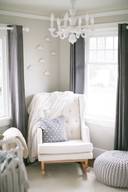Nursery tips

Nursery tips
Baby cots, also known as cribs or baby beds, are essential pieces of furniture designed to provide a safe and comfortable sleeping environment for infants and young children. Here are some key features and considerations when choosing a baby cot:
-
Safety Standards: Ensure that the cot meets safety standards established by relevant authorities in your country. Look for certifications such as ASTM International (in the US), or the European safety standard EN 716.
-
Sturdy Construction: The cot should be made of durable materials such as solid wood or metal, with sturdy construction to withstand the weight and activity of a growing baby.
-
Mattress Support: Check the mattress support system to ensure it's firm and secure. Adjustable mattress heights are helpful to accommodate your baby's growth and development stages.
-
Slat Spacing: The distance between the slats should be narrow enough to prevent the baby's head from getting trapped, typically less than 2.375 inches (6 cm) apart.
-
Drop-Side Cots: Avoid purchasing drop-side cots, as they have been banned in many countries due to safety concerns. These cots pose a risk of entrapment and suffocation.
-
Convertible Options: Some cots can convert into toddler beds or even full-sized beds, providing long-term value and versatility.
-
Size and Space: Consider the dimensions of the cot in relation to the available space in your nursery or bedroom. Ensure there's enough room for the cot and other necessary furniture without creating a crowded environment.
-
Portability: If you anticipate the need to move the cot frequently, consider a portable or travel cot that is lightweight and easy to assemble and disassemble.
-
Style and Aesthetics: Choose a cot that complements your nursery décor and personal style preferences. There are various designs available, from traditional to modern, in a range of colors and finishes.
-
Budget: Set a budget based on your preferences and needs, keeping in mind that safety and quality are paramount considerations.
Remember to regularly check and maintain the cot for any signs of wear or damage, and always follow the manufacturer's assembly instructions and safety guidelines. Additionally, avoid using soft bedding, pillows, or toys in the cot to reduce the risk of suffocation or Sudden Infant Death Syndrome (SIDS).
Maintaining cleanliness in a nursery is crucial for creating a safe and healthy environment for your baby. Here are some tips to help you keep your nursery clean:
-
Regular Cleaning Schedule: Establish a routine cleaning schedule to ensure that the nursery stays tidy and hygienic. Daily tasks may include dusting, wiping surfaces, and picking up toys, while weekly tasks may involve more thorough cleaning, such as vacuuming and mopping the floors.
-
Keep Clutter to a Minimum: Clutter not only makes cleaning more difficult but can also harbor dust and allergens. Keep the nursery organized by regularly decluttering and finding storage solutions for toys, clothes, and other items.
-
Use Safe Cleaning Products: Choose cleaning products that are safe for use around babies and children. Look for non-toxic, hypoallergenic, and fragrance-free options to minimize the risk of exposure to harmful chemicals.
-
Disinfect High-Touch Surfaces: Pay special attention to high-touch surfaces such as changing tables, crib rails, door handles, and light switches. Use disinfectant wipes or a mild solution of water and vinegar to clean and disinfect these areas regularly, especially during cold and flu season.
-
Wash Bedding Frequently: Wash your baby's bedding, including sheets, blankets, and crib bumpers, on a regular basis. Use a gentle detergent and hot water to remove dirt, dust, and bacteria. It's also a good idea to have spare bedding on hand for quick changes.
-
Ventilation: Ensure adequate ventilation in the nursery by opening windows or using a fan to improve air circulation. Proper ventilation helps prevent the buildup of indoor pollutants and reduces the risk of respiratory issues.
-
Clean Toys and Accessories: Toys, pacifiers, and other accessories that come into contact with your baby's mouth should be cleaned regularly. Follow manufacturer recommendations for cleaning and disinfecting these items, and avoid using harsh chemicals that could be harmful to your baby.
-
Monitor Indoor Air Quality: Indoor air quality can impact your baby's health and comfort. Consider using an air purifier with a HEPA filter to remove allergens, dust, and other pollutants from the air.
-
Pet Care: If you have pets, keep their bedding and living areas clean to minimize the spread of pet dander and allergens. Consider limiting your pet's access to the nursery to reduce exposure to pet hair and other potential allergens.
-
Regular Inspections: Periodically inspect the nursery for any signs of mold, mildew, or pest infestations. Address any issues promptly to prevent them from worsening and impacting your baby's health.
By following these tips and maintaining a consistent cleaning routine, you can create a clean and healthy nursery environment for your baby to thrive in.
